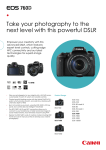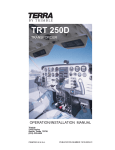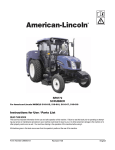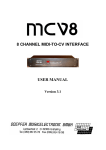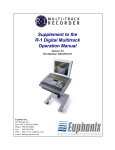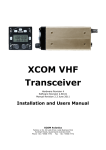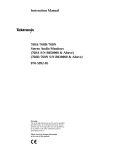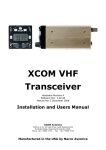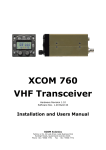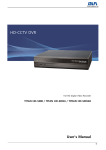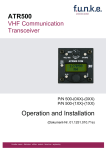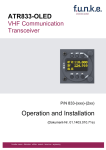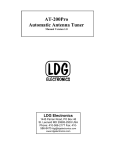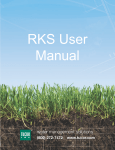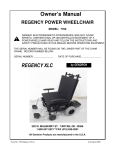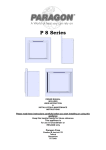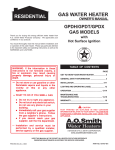Download Terra TX760D Installation and User Manual
Transcript
TX 760D VHF COMMUNICATION TRANSCEIVER OPERATION/INSTALLATION MANUAL Trimble 2105 Donley Austin, Texas 78758 (512) 432-0400 PRINTED IN U.S.A. PUBLICATION NUMBER 82619 TX 760D VHF COMMUNICATIONS TRANSCEIVER OPERATION/INSTALLATION MANUAL PUBLICATION NUMBER 82619 Trimble 2105 Donley Austin, Texas 78758 (512) 432-0400 PRINTED IN U.S.A. REVISION B DECEMBER 16, 1996 Title Page T-1 Terra by Trimble TX 760DVHF Communication Transceiver Insert latest change pages and destroy superceded pages. LIST OF EFFECTIVE PAGES Dates of Change pages are: Revision ........... A ......... November 25, 1996 Page Description Page no. Title Page T-1 November 25, 1996 List of Effective Pages A November 25, 1996 Record of Revisions B November 25, 1996 Table of Contents (Main) TC-1 - TC-2 November 25, 1996 Section I - Introduction 1-1 - 1-4 November 25, 1996 Section II - Installation 2-1 - 2-10 November 25, 1996 Section III - Installation Drawings 3-1 - 3-14 November 25, 1996 Section IV - Operation 4-1 - 4-6 November 25, 1996 Section V - Warranty 5-1 - 5-2 November 25, 1996 Section VI - Installation Bulletins/Notes 6-1 -6-2 November 25, 1996 Revision A November 25, 1996 Date Page A Terra by Trimble TX 760DVHF Communication Transceiver RECORD OF REVISIONS Assigned To (Job Title) Rev No. Revision Date Revision A November 25, 1996 Location Insertion Date By Rev No. Revision Date Insertion Date By Page B Warranty Registration Card Complete and Return Model No. _________________________ Serial No. _______________ Purchased On _________________ Purchased From _________________________________________________________________________ City ______________________________ State ___________________ Country ______________________ Owner's Name ___________________________________________________________________________ Address ________________________________________________________________________________ City ____________________________ State ________ Zip ___________ Country ___________________ Telephone (work) _______________________________ (home) ___________________________________ Installed In (Make & Model) ______________________________________ Tail No. ____________________ Factory Aircraft Experimental UltraLight Sailplane Balloon Ground Vehicle While not required for warranty registration, the following information will help us better serve you. Have you purchased Trimble equipment before? YES NO If yes, are you satisfied with the equipment and customer service? YES NO What were your two most important reasons for selecting Trimble avionics? ______________________________________________________________________________________ ______________________________________________________________________________________ What are the two aviation related publications you read most often? ______________________________________________________________________________________ ______________________________________________________________________________________ Ratings you currently hold? VFR Instrument Instructor Commercial Trimble Manufactures a Full Line of Aviation Products. Visit your local dealer, call 1-800-497-4662 or indicate below for information on: Communication Transceiver Navigation Receiver Audio Panels Transponder Radar Altimeters Airborne Telephone Systems Selective Calling System ADF System Global Positioning System Emergency Battery Backup Marker Beacon Receiver Altitude Encoder FOLD FOLD From: __________________________________________ ______________________________________ ______________________________________ ______________________________________ Place Stamp Here Trimble 2105 Donley Drive Austin, TX 78758 FOLD FOLD TX 760D VHF COMMUNICATIONS TRANSCEIVER OPERATION/INSTALLATION MANUAL TABLE OF CONTENTS SECTION I ............................................................................................................................... 1-1 1. INTRODUCTION .......................................................................................... 1-1 1.1 SCOPE .............................................................................................. 1-1 1.2 DESCRIPTION ................................................................................. 1-1 1.3 SPECIFICATIONS ........................................................................... 1-2 1.4 EQUIPMENT SUPPLIED ................................................................ 1-3 1.5 ADDITIONAL EQUIPMENT REQUIRED ..................................... 1-4 1.6 LICENSE REQUIREMENTS ........................................................... 1-4 SECTION II .............................................................................................................................. 2-1 2. INSTALLATION .......................................................................................... 2-1 2.1 GENERAL ....................................................................................... 2-1 2.2 PREPARATION FOR USE .............................................................. 2-1 2.3 GENERAL INSTALLATION INSTRUCTIONS FOR AVIONICS .............................................................................. 2-1 2.4 INSTALLATION .............................................................................. 2-5 2.5 ANTENNA INSTALLATION ......................................................... 2-9 2.6 OPERATIONAL CHECKOUT ........................................................ 2-9 2.7 FINAL INSPECTION ....................................................................... 2-7 SECTION III ............................................................................................................................ 3-1 3. INSTALLATION DRAWINGS .................................................................... 3-1 SECTION IV ........................................................................................................................... 4-1 4. OPERATION ................................................................................................. 4-1 4.1 SCOPE .............................................................................................. 4-1 4.2 OPERATION .................................................................................... 4-1 4.3 FREQUENCY MODE ...................................................................... 4-1 4.4 NORMAL OPERATION .................................................................. 4-1 4.5 FREQUENCY TRANSFER ............................................................. 4-2 4.6 COMM TUNING KNOB OPERATING SEQUENCE .................... 4-2 4.7 MEM (MEMORY) OPERATING SEQUENCE .............................. 4-2 4.8 TO PROGRAM A NEW FREQUENCY INTO MEMORY ............ 4-3 4.9 DISPLAY BLANKING OPERATION ............................................. 4-3 4.10 VOX INTERCOM OPERATION ..................................................... 4-4 4.11 EMERGENCY OPERATION .......................................................... 4-4 4.12 BLIND OPERATION ....................................................................... 4-5 4.13 FAILURE MODE OPERATION ...................................................... 4-5 4.14 SAFEGUARDS OPERATION ......................................................... 4-5 Revision A November 25, 1996 TC-1 SECTION V ............................................................................................................................. 5-1 5. WARRANTY ................................................................................................ 5-1 5.1 LIMITED WARRANTY OF TERRA BY TRIMBLE PRODUCTS 5-1 SECTION VI ............................................................................................................................ 6-1 6. INSTALLATION BULLETINS/NOTES ...................................................... 6-1 6.1 INSTALLATION BULLETINS ....................................................... 6-1 6.2 INSTALLATION NOTES ................................................................ 6-2 TC-2 Revision A November 25, 1996 SECTION I 1. INTRODUCTION 1.1 SCOPE This manual provides installation and operation instructions for the Terra by Trimble TX 760D VHF Communications Transceiver manufactured by Trimble of Austin, Texas. 1.2 DESCRIPTION The Terra by Trimble TX 760D is a small, lightweight, all solid-state, amplitude modulated, 5 watt VHF transceiver. The TX 760D provides simplex communication on any one of 760 channels with 25 KHz spacing. Featuring a planar gas discharge digital display, the TX 760D provides active and standby frequency indication, memory, and knob operated frequency selection. The TX 760D features a digital frequency synthesizer that employs one crystal for generating the frequencies required for transmit and receive functions on all 760 channels. Other features include automatic voice leveling on transmit, crystal monolithic I.F. filters, integrated circuit I.F. amplifiers, and internal two place VOX intercom capability. Use of a low noise MOSFET RF amplifier, automatic squelch circuit with manual override, solid-state antenna switching, switching power supply with overload protection, and microprocessor controlled frequency selection and monitoring make the TX 760D a reliable answer to today’s communication requirements. The transceiver can be mounted in two different configurations; in a single tray or in a dual tray. All power and control connections are made through a 15 pin “D” type connector installed on the rear of the mounting tray. A BNC chassis connector is used for antenna connections. The TX 760D is secured by means of a positive locking cam, accessible through the front panel, using a 7/64" Allen wrench. Weighing only 1.50 lb. (0.680 kg), the TX 760D measures 11.45" long, 3.125" wide, and 1.625" high (29.08 cm x 7.9375 cm x 4.1275 cm). Panel cutout is a 3.03" x 1.54" (7.6962 cm x 3.9116 cm) and overall length of the unit is 13.05" (33.147 cm) including mounting tray. The TX 760D is very power efficient, requiring only 325 mA of standby current and 2.5 A during transmit. Operation at 27.5 VDC is possible by utilization of an optional Terra by Trimble MLC 28-5 power converter. The TX 760D is designed to operate with standard aircraft microphones, headsets, speakers, auxiliary audio inputs and 50 ohm broad-band communication antenna systems. 1.3 SPECIFICATIONS Revision A November 25, 1996 1-1 The following are pertinent specifications for the FCC type-accepted Terra by Trimble Model TX 760D transceiver. 1.3.1 MECHANICAL SPECIFICATIONS Mounting: Overall Dimensions: Panel mounted using mounting tray supplied with unit 13.05" long, 3.125" wide, 1.625" high (33.14 cm long, 7.9375 cm wide, 4.1275 cm high) Mounting Dimensions: 11.45" behind panel, 3.125" wide, 1.625" high (29.08 cm behind panel, 7.9375 cm wide, 4.1275 cm high) Panel Cutout: 3.03" x 1.54" (7.692 cm x 3.9116 cm) Weight: 1.50 pounds (0.680 kg) Connectors: Antenna input/output; BNC Interconnect; 15 pin “D” type 1.3.2 POWER REQUIREMENTS The Terra by Trimble TX 760D transceiver requires 13.75 VDC +10%, -20% input at 2.5 amps maximum load condition. 1.3.3 ENVIRONMENTAL SPECIFICATIONS Maximum Operating Conditions Altitude: Humidity: Temperature Range: Vibration: 1.3.4 -20 C (-4 F) to +55 C (+131 F) 0.5 G from 5 to 500 Hz ELECTRICAL SPECIFICATIONS (All specifications at 13.75 VDC nominal) RECEIVER Frequency Range: Number of Channels: Channel Spacing: Sensitivity: Selectivity: Squelch Sensitivity: Manual: Automatic Gain Control (AGC): Undesired Response: 1-2 To 30,000 feet (9,150 meters) To 95% at 50 C (122 F) 118.00 to 136.975 MHz 760 25 KHz Less than 2 µV for 6dBm signal plus noise to noise ratio. Typically -6dBm at 14 KHz and -60 dBm at 40 KHz. Automatic: 2 to 5 µV 25 to 150 µV Audio flat within 3dB for 3 µV to 30,000 µV input. Greater than 60dBm down. Revision A November 25, 1996 Adjacent Channel Rejection: Auxiliary Inputs: Incidental Radiation: TRANSMITTER Frequency Range: Number of Channels: Frequency Stability: Power Output: Modulation: Emmision Type: Output Termination: Spurious Responses: Sidetone: FCC Approval: 1.4 Greater than 60dBm. 3 inputs with minimum of 30dBm isolation. One volt input at 1 Khz will produce one volt output across a 3.2 ohm resistor connected to the speaker terminals. Certified per FCC Part 15 requirements. 118.00 to 136.975 MHz 760 +0.002% per FCC Type Acceptance. 5 watts nominal, unmodulated carrier. Automatic audio leveling for a minimum of 80% and a maximum of 95%. 6K00A3E 50 nominal. Greater than 50 dBm below carrier level. Up to 25 milliwatts into 600 headphones. Type accepted per FCC Part 87. EQUIPMENT SUPPLIED The equipment supplied will depend upon the “system” you have ordered. The part numbers and descriptions listed below indicate the equipment supplied with the TX 760D only. If a system other than those listed below was ordered, additional equipment will have been supplied and listed in another manual. 0990-0405-10 TX 760D, Single System 1. 1ea 2. 1ea 3. 1ea 4. 1ea 5. 6. 1ea 1ea 7. 1ea Comm Transceiver, Terra by Trimble TX 760D P/N 1900-0361-00 Mounting Tray, Single P/N 1900-0357-10 Installation Kit P/N 1901-2671-10 Operation/Installation Manual TX 760D P/N 82619 Warranty Card FCC Form 404 P/N 1900-0607-00 FCC Form 406 P/N 1900-0608-00 Revision A November 25, 1996 1-3 1.4.1 OPTIONAL EQUIPMENT Noise-canceling Microphone, Carbon, Push-to-talk Terra by Trimble P/N 0900-0151-01 Voltage Converter 27.50 to 13.75 V Model MLC 28-5 Terra by Trimble P/N 0900-3219-12 Push-to-talk Switch Terra by Trimble P/N 0900-0203-01 Headset with Microphone Terra by Trimble P/N 0900-0201-11 Ext. VOX Kit, Pot. and Knobs Terra by Trimble P/N 1901-5322-00 1.5 ADDITIONAL EQUIPMENT REQUIRED 1. 2. 3. 4. 5. 1.6 Sufficient RG 58A/U 50 co-axial antenna cable to reach from the transceiver to the antenna. BNC co-axial fittings as required for the particular installation. If cable length exceeds 20 feet RG8 co-axial cable is recommended MIL 22759 or equivalent wire sufficient to make the harness. Microphone and headphone jacks as required. Circuit breaker rated at 4 amps. 50 ohm communications antenna rated at top speed of the aircraft. LICENSE REQUIREMENTS The operator of the Terra by Trimble TX 760D transceiver is required by the Federal Communications Commission to hold a restricted radio-telephone operator’s permit, or a higher class of license. A U.S. citizen may obtain the operator permit from the nearest FCC office. The transceiver, when installed in an aircraft, requires an Aircraft Radio Station License. This license may be obtained by filing an FCC Form 404. The transceiver should be identified on the form as CCXTX760D under Type Acceptance Number. If a copy of the filed Form 404 is kept in the aircraft, the TX 760D may be operated up to 30 days while awaiting the formal license. For Ground Station operation, Form 406 should be filed as above. 1-4 Revision A November 25, 1996 SECTION II 2. INSTALLATION 2.1 GENERAL This section contains all necessary installation instructions and check-out procedures for the Terra by Trimble TX 760D VHF Communications Transceiver. For the installer with little or no experience of installing avionics, Section 2.3 provides important information. Trimble recommends reading this section before continuing with the installation. 2.2 PREPARATION FOR USE Every precaution has been taken to protect the TX 760D during shipment. Upon receipt of the equipment, perform the following inspections: 1. 2. 3. Remove the unit from the shipping container and visually inspect for damage. Check controls and switches to determine if they may have been damaged. Make sure that all hardware and connectors listed in Section I, under “Equipment Supplied” are present. If the unit is damaged, a claim must be filed with the carrier. The carrier assumes title of the unit when accepted for shipment. Do NOT return the unit to Trimble or its representatives. It is suggested that the package be retained for inspection by the carrier in the case of damage or for future use should it be necessary to ship the unit for service or to transfer it to another location. 2.3 GENERAL INSTALLATION INSTRUCTIONS FOR AVIONICS The following paragraphs contain pertinent hints, advice, and guidance intended for use by installers of avionics equipment. These have been drafted to address common problems encountered during the installation process. Specific questions may be addressed to Trimble for technical assistance by calling 1-800-487-4662 and requesting Technical Assistance. 2.3.1 COAXIAL CABLES AND CONNECTORS Improper installation of coaxial cables and connectors create many of the problems encountered during avionics installations. Refer to Figure 3-1 for guidance of typical BNC connector assembly. Refer to Figure 3-2 for instructions about connecting coax cable to the BNC connector(s) mounted at the rear of Terra by Trimble mounting trays. Problems to avoid include twisted, chafed, or pinched cables, sharp bends in cables, open or shorted center conductors or shield braid, and improper grounding of shields. Also, proper termination of antenna coaxial cables at the antenna should be carefully checked. After installing connectors, pull firmly to ensure good mechanical bonding (particularly if you use crimp-on connectors) and use your ohmmeter to insure good electrical connection with no shorting. Be sure that coax lengths and types follow the avionics manufacturer’s recommendations. Revision A November 25, 1996 2-1 2.3.2 ANTENNAS The three cardinal points for antenna installation are location, mounting and electrical characteristics. Antenna Location: Select a location that provides an adequate ground plane, a continuous unbroken surface of metal. At VHF frequencies, a minimum of a 42 inch diameter circle with the antenna at center is recommended. Provide an area where shadowing of the antenna will not occur (eg. blocking of the signal by other parts of the aircraft). Remember that at VHF frequencies and above, direct line of sight signals are required from ground stations to the antenna for maximum effective range. Consider that close proximity of an antenna to other antennas or noise sources may create interference problems. Read carefully and follow closely the recommendations of the antenna manufacturer about antenna location. It is particularly important for VHF communication antennas that the 42 inch diameter ground plane area be provided for each antenna, and the ground plane surface must be relatively flat. Serious problems are often encountered in aircraft which include composite materials or fabric surfaces and in many cases ground plane should be added if normal communication range is to be achieved. The effect of a limited or restricted ground plane is a severe reduction of the antenna gain radiation pattern in the direction of the restriction. For example, if an antenna is mounted less than 21 inches from the edge of a ground plane surface, then both the range of reception and transmission to that direction will be reduced in direct correlation with how much closer than 21 inches that antenna is mounted from the edge. Another undesirable antenna placement occurs when a VHF communication antenna is placed within 21 inches from a second VHF communication antenna, or within 21 inches of the metallic vertical edge of the tail assembly, etc. The effect is reduction of antenna gain radiation pattern to the direction of the other antenna or the vertical edge. The 21 inch separation is an absolute minimum! Antenna Mounting: Proper attachment of any antenna to the aircraft surface is of primary importance. Carefully clean all paint and corrosion off the mounting surface and apply an anticorrosion treatment. Do the same to the inside surface if a backing or nut plate is to be used. Mount the antenna securely per the antenna manufacturer’s recommendations and check carefully to insure good electrical bonding. Do not mount any antenna to doors, hatches, inspection plates or other moveable surfaces because proper bonding to the aircraft surface cannot be accomplished. After proper mounting and bonding is achieved, a bead of high quality RTV around the junction of the antenna base and the aircraft surface will prevent water seepage and corrosion from forming between the antenna base and aircraft surface. 2-2 Revision A November 25, 1996 2.3.2 ANTENNAS (CONTINUED) Antenna Electrical Characteristics: Use the antenna supplied with the avionics equipment, or if not supplied, the antenna(s) recommended by the avionics manufacturer. If no specific antenna is recommended, choose an antenna which provides good service for the frequency range and the service conditions of the aircraft (eg. speed, altitude, etc.). If a signal splitter is to be used, compare the specifications carefully to the application. Many installation problems are encountered with improper application of signal splitters! If in doubt, test the power and frequency characteristics of the splitter on the bench to be sure. Simple antenna problems such as shorting or open circuit problems can be determined by use of an ohmmeter, although certain types of antennas may require use of ramp test equipment to check radiation. But, by far, the most common antenna problems are diagnosed to be coax or connectors, antenna bonding, or signal splitters. Never allow an aircraft antenna to be painted. 2.3.3 WIRING AND HARNESSING Construct the installation wiring harness carefully from the avionics manufacturer’s wiring diagram. Be extremely careful to note recommended wire sizes, the need for shielded wiring (if any), and decide upon any optional wiring to be included. Measure carefully and plan the harness layout to avoid interference of the cable harness with existing avionics, instruments or controls. Remove the connector plates from the rear of the trays. Connect all wires to the proper pin of each connector, checking as you go to insure that no loose strands cause shorting to adjacent pins or to ground surfaces. We recommend tubing be placed over each soldered pin connection to prevent wire strands from touching adjacent connections. Be particularly careful with the shield braids of shielded wires. Do not expose any more of the conductor than is absolutely necessary and keep the braid connection as short as possible. Remember that on shielded wires only one ground point is recommended. Follow manufacturer’s recommendation about where the ground point should be located. After completing all connections, check wiring with an ohmmeter again to ascertain that all connections are as desired and that no undesired shorting to ground or other pins has occurred. Visually double check to see that braids on shields are not creating shorting, that no insulator melting has occurred during soldering and pull firmly on all connections to insure good mechanical bond. Install the harness and connectors/connector plates in the aircraft with very loose dress only. Solder all connections to power and ground and install panel components/controls and safety devices (eg. fuses or breakers). It is desirable at this point to insert all equipment in trays and perform preliminary check-out. Following a satisfactory check-out, and with all equipment in the properly installed location, complete the final dressing and routing of the harness and secure in place. Revision A November 25, 1996 2-3 2.3.3 WIRING AND HARNESSING (CONTINUED) NOTE: It is extremely important that units should be installed in trays while final dress and bundling of the harness is accomplished to assure proper alignment of connectors between tray and unit. Failure to do this may cause problems when unit is initially inserted into tray due to misalignment of connectors! The final step is to perform a complete check of all avionics operations and insure that free movement of all cockpit controls is available. 2.3.4 NOISE AND INTERFERENCE The typical airframe is a small and imperfect platform for providing all of the antenna ground planes and power sources and inter-wiring required for avionics operations, particularly for a low noise and interference free expectation. This subject is far too broad and complex to address in detail in a few paragraphs. However, an approach to categorizing and defining the problem can be outlined. Noise and/or interference is usually heard in the audio systems, although it may also be detected as an interference to indicator operation. Unless a strong suspicion of the exact source is suspected, it is best to begin a process of elimination, in the following order: 1. 2. 3. 2-4 Power Source: Check for low voltage when the avionics load is applied. A high resistance battery cell in the A/C can cause numerous problems. View the avionics power line at the avionics master and at the affected unit for noise on the power line. If present, try to categorize the frequency (eg. alternator whine, which may be caused by one or more bad alternator diodes, or if interference is present only when a communication unit is transmitting, etc.). If the noise is present or worse at the affected unit than at the avionics master, investigate the harness for noise coupling between wires. If necessary, disconnect the affected unit power from the aircraft power source and connect to an external power supply or battery. Power Ground: View the power ground line at the avionics master and the affected unit. If noise is discerned at the master source, ground strapping may be corroded or partially broken. If only at unit, a larger wire size or wire re-routing may be required. Interference: Both noise and interference may be either conducted or radiated, and in some cases electromagnetically coupled between units. If it is determined that the noise or interference is eliminated whenever another avionics unit is not transmitting, first investigate the radiated alternative. Insure complete and proper bonding of antennas to the aircraft surface, and check the coaxial cable and all shield connections and connectors. Review the manufacturer’s recommendations for antenna separations. Be aware that antenna radiation directly to conductors at the rear of mounting trays or units may occur if shields are stripped too far back from the connector or are improperly grounded. Disconnecting the interfering antenna and substituting an external dummy load may assist diagnosis. Revision A November 25, 1996 2.3.4 NOISE AND INTERFERENCE (CONTINUED) 4. 2.3.5 Conducted interference usually occurs through paths which are shared by the avionics equipment such as power lines, ground points, audio equipment, or induced interference between adjacent wires or harnesses. Review the manufacturer’s recommendations for shielded wiring and ground points, and for separation of specific wires. Measure ground points for a small but perceptible resistance to true ground and view power lines with an oscilloscope, turning each unit on and off to detect changes. Recheck common or adjacent connections to jacks, plugs, or shared equipment such as power converters, breakers, or audio panels. Compromise: In some cases noise or interference may be subdued but not eliminated. With the inefficient and imperfect platform provided by the aircraft for antennas and power source, etc, complete elimination of the problem may be very expensive or impossible (eg. if there is simply not enough space to provide ground plane or antenna separation as recommended). Or, the aircraft strobe noise is audible but not objectionable, etc. These problems should be discussed early and thoroughly with the customer. SUMMARY The paragraphs above are not intended to be highly technical, completely thorough, or extensive, but serve as a reminder for certain precautionary or follow-up procedures for general avionics installations. Trimble is prepared to assist at any point with additional information, hints, or literature. Simply call 1-800-487-4662 and ask for technical assistance. 2.4 INSTALLATION Installation of any equipment in an aircraft requires that the work be performed by a Certificated Radio Repair Station with appropriate ratings. The installing agency must complete an FAA Form 337 and compute a new weight and balance for the aircraft for insertion in the Aircraft Flight Manual. Unless the mechanic is the designated inspector for a Certificated Radio Repair Station or holds an Inspection Authorization, the work is subject to inspection and approval by an FAA inspector or the holder of an Inspection Authorization. Revision A November 25, 1996 2-5 2.4 INSTALLATION (CONTINUED) The following items and suggestions should be considered prior to installation or the Terra by Trimble TX 760D Transceiver: 1. 2. 3. 4. 5. Discuss the location of this transceiver with your customer, preferably in a position that provides ease of operation. The location of the TX 760D in relation to the pilot’s viewing angle is very important. Due to the small size of the TX 760D, the vertical viewing angle for the display should not exceed 30 degrees. Avoid installing the TX 760D near heat sources. If unavoidable, insure additional cooling is provided. Insure that adequate clearance exists behind the panel for connectors, cable bends, and additional cooling if required. A minimum of 14" (35.56 cm) is recommended. Refer to Terra by Trimble TX 760D outline drawings for panel cut-out details and mounting dimensions as well as pertinent notes. Install the sleeve assembly in the instrument panel. Insure compliance with standards set forth in FAA Aircraft Inspection and Repair Document AC 43.13-2A. NOTE: Ensure that the sleeve is installed with the largest opening toward the top. 6. The 15 pin “D” connector assembly supplied with the Terra by Trimble TX 760D must be wired correctly to the aircraft avionics systems or severe damage may result to the Terra by Trimble TX 760D or other systems. The interconnecting wiring for the 15 pin “D” connector is shown in Figure 3-6. Comply with standards set forth in FAA Aircraft Inspection and Repair Document AC 43.13-1A Section 7 and other pertinent FAR’s as required. Insure mil-spec wire is utilized for all interconnects. NOTE: It is recommended that the TX 760D be installed and locked into the mounting sleeve before tying and securing the wiring harness. This will ensure proper alignment of the “floating” connectors to facilitate easy removal and installation of the TX 760D. CAUTION! The operating voltage of this Terra by Trimble TX 760D is 13.75 V nominal for direct connection to an aircraft 12-14 volt electrical system. If the aircraft electrical system supply is 24-28 volt, it is necessary to employ a converter to reduce the 28 volts to 13.75 volts for the Terra by Trimble TX 760D. Trimble can supply an optional converter specifically designed for this purpose. It is Terra by Trimble P/N 0900-3219-12, Model MLC 28-5. 2-6 Revision A November 25, 1996 a. b. 7. 8. 9. 10. NOTE: If a loudspeaker is not used it will be necessary to connect a 15 ohm 3 watt resistor across the speaker terminals (pin 12 and pin 15) of the 15 pin “D” connector. Failure of the output circuit could occur if this load is not installed. If the installation is a retrofit of a TX 720, care must be taken to properly rewire the connector or damage and incorrect operation will result. Should the customer desire the VOX Intercom feature, it is recommended that a relay be used in the manner described on the Interconnect Diagram, Figure 3-6. If this is not done, the co-pilot’s microphone will be “hot” during transmit and both mic audio signals will be transmitted simultaneously. Another option for use with the VOX Intercom feature is an external VOX Intercom squelch adjustment. This requires a potentiometer (100 k , 1/4 W) to be installed as per Note #5 on Figure 3-6. When using this option on Units, the Vox Intercom squelch adjustment on the TX 760D must be turned fully CCW and shorting jumper SJ601 must be removed for proper operation. SJ601 can be located on drawing Figure 3-4. Yet another option for use with the VOX Intercom feature is an external VOX Intercom volume adjustment. This requires a potentiometer (10 k , 1/4 W, Audio taper) to be installed as per note #6 on Figure 3-6. When using this option, the VOX Intercom volume adjustment on the TX 760D must be fully CW and shorting jumper SJ602 removed for proper operation. SJ602 can be located using component locator Figure 3-4. Install the TX 760D in the mounting sleeve assembly. Use caution as the rear connectors mate. After the float mounts are positioned correctly, (a little twisting at the front panel may be necessary), the unit will fully engage the connectors with light to medium pressure on the front panel. CAUTION: DO NOT PUSH UNIT INTO SLEEVE WITH THUMBS ON LENS AS DISPLAY DAMAGE MAY RESULT! Insert a 7/64" Allen wrench in the front panel hole and engage the locking screw. Turn clockwise until the cam has engaged itself in the sleeve and is moderately tightened. Use caution to prevent stripping the threads on the locking cam or screw. To remove the unit from the mounting sleeve, insert the 7/64" Allen wrench in the locking screw and turn counterclockwise. The cam will move the unit outward about 1/4" and disengage the connectors. The unit may now be pulled out of the mounting sleeve by hand. Revision A November 25, 1996 2-7 2.4 INSTALLATION (Continued) 11. 12. The connector is mounted from the front side of the sleeve with two Phillips head screws and lock washers. As viewed from the front of the unit, pin 1 of the connector is top right and pin 15 is bottom left. The following items are preset at the factory to nominal levels, but individual pilot desires and installations may require field adjustments. For these adjustments, access holes have been provided in the covers of the TX 760D. Figure 3-3 shows the locations of these access holes. A. Sidetone Volume If the installation requires more (or less) volume into the headphones during transmit the sidetone volume adjustment is used. Turning clockwise will increase the volume and turning counterclockwise will decrease the volume. B. VOX Intercom Squelch If the VOX Intercom is breaking on ambient noise or is not breaking soon enough the VOX Intercom squelch adjustment is used. Turning counterclockwise will allow the squelch to break at lower microphone levels and turning clockwise will require more microphone audio to break squelch. NOTE: If using the External VOX Intercom squelch adjust option this adjustment must be turned fully CCW and shorting jumper SJ601 removed for proper operation of the External VOX squelch adjustment. C. Intercom Volume If the installation requires more (or less) intercom volume into the headphones the Intercom Volume adjustment is used. Turning counterclockwise will decrease the headphone volume level and turning clockwise will increase the headphone volume level. NOTE: If using the external VOX Intercom volume adjust option, this adjustment must be turned fully CW and shorting jumper SJ602 removed for proper operation of the external VOX Intercom volume adjustment. See Component Locator, Figure 3-4 for location of SJ601 and SJ602. 2-8 Revision A November 25, 1996 2.5 ANTENNA INSTALLATION A 50 broad-band VHF communication antenna covering the range of 118.00 to 136.975 MHz is recommended. Whips or bent antennas do not provide the best performance if the radio is to be used over its entire range of 118.00 to 136.975 MHz. Connect the antenna to the Terra by Trimble TX 760D using standard 50 ohm coaxial antenna cable such as RG 58A/U. Terminate the cable with BNC coaxial cable connectors as required. Insure tested speed of the antenna matches top speed of the aircraft. Minimum ground plane size is recommended to be a 42" diameter circle around antenna mounting point to prevent loss of transmit range. CAUTION! Proper installation of the coaxial cable and the antenna per FAA Aircraft Inspection and Repair Document AC 43.13-2A, Chapter 3, is very important to prevent possible mismatch of the transmitter output. Use an ohm meter to verify no short curcuits exist between the center conductor and shield conductor or other wiring. 2.6 OPERATIONAL CHECK-OUT 1. 2. 3. 4. 5. 6. 7. Revision A November 25, 1996 Rotate volume control (small inner left hand knob) clockwise to turn transceiver on. Rotate “Tune” (right hand) knob to obtain desired frequency in right-hand window. Verify that the faster the knob is rotated, the more the frequency changes with each detent. Press the “<—>” (TRANSFER) button and verify that the two frequencies “swap” sides in the display. Adjust squelch control (large outer left hand knob) until the switch clicks into a fully counterclockwise position. This is the automatic squelch mode. No background noise should be heard. If there is a received signal it should be heard. Rotating the squelch control in a clockwise direction activates the manual squelch mode. Rotate the control clockwise until background noise is heard. Adjust volume control for desired level during receipt of transmissions. Then rotate squelch control slightly counterclockwise until the noise ceases. Plug microphone into remote microphone jack. Verify proper transmitter operation by communicating with another station. Verify at the low, medium, and high frequencies if possible. Plug headset into remote jack and observe the quality of audio output. If transmit sidetone is used, verify quality and level in headset. 2-9 2.7 FINAL INSPECTION 1. Insure that all wiring is properly routed and secure. Dress harnessing neatly and secure in place with cable ties. NOTE: It is recommended that the TX 760D be installed and locked into the mounting sleeve before tying and securing the wiring harness. This will ensure proper alignment of the “floating” connectors to facilitate removal and replacement of the TX 760D. Check connector integrity and locking devices. Insure locking devices are functioning properly and are secured. Verify cabling is not “clotheslined” and provisions have been made for service loops. Pull yoke to its maximum travel. While slowly returning yoke to its normal position, rotate yoke left and right to insure all cabling is routed and tied up properly. Cycle rudder pedals and verify that they are free and cables are unobstructed. Install gust locks, perform complete check-out of all avionics including dimmers. Secure aircraft power and all master switches. 2. 3. 4. 5. 2-10 Have installation inspected by someone authorized under Federal Aviation Regulation Part 65. Add the Terra by Trimble TX 760D to the aircraft equipment list, including serial number. Complete FAA Form 337 if required, and make required airframe logbook entries. A weight and balance change may be required, depending on the type of aircraft. Complete FCC License Applications as required and file them. The Type Acceptance Number for the application is CCXTX760D. Complete warranty card and return to Trimble. Revision A November 25, 1996 SECTION III 3. INSTALLATION DRAWINGS Figure 3-1 Typical BNC Connector Assembly Revision A November 25, 1996 3-1 THIS PAGE INTENTIONALLY LEFT BLANK 3-2 Revision A November 25, 1996 Figure 3-2 Coax Connector Drawing Revision B December 16, 1996 3-3 THIS PAGE INTENTIONALLY LEFT BLANK 3-4 Revision A November 25, 1996 Figure 3-3 Adjustment Locations Revision A November 25, 1996 3-5 THIS PAGE INTENTIONALLY LEFT BLANK 3-6 Revision A November 25, 1996 Figure 3-4 VOX Jumper Locations Revision A November 25, 1996 3-7 THIS PAGE INTENTIONALLY LEFT BLANK 3-8 Revision A November 25, 1996 Figure 3-5 (Sheet 1 of 2) Outline Dimensions Revision A November 25, 1996 3-9/10 Figure 3-5 (Sheet 2 of 2) Outline Dimensions Revision A November 25, 1996 3-11/12 Figure 3-6 Interconnect Diagram Revision A November 25, 1996 3-13/14 SECTION IV 4. OPERATION 4.1 SCOPE This section covers operation procedures for the TX760D. 4.2 OPERATION See Figure 4-1 for locations and descriptions of the TX 760D Front Panel Controls. CAUTION! Ensure the TX 760D is turned off until after engine start-up procedures are completed. This simple precaution will greatly improve the lifetime of all of your avionics as well as your new TX 760D. 4.3 FREQUENCY MODE To turn power on, rotate the small inner left knob clockwise. A slight detent will be felt. The following will be displayed in the window: 188.88 T/R 8 m 188.88 After 5 seconds the displays will revert back to the last used frequencies. Enter your desired frequency in the right hand or “standby” window, by turning the tune knob on the right-hand side. Clockwise tuning increases the frequency and counterclockwise tuning decreases the frequency. At the upper and lower limits of the frequency band i.e., 118.00 and 136.975, the frequency will “wrap around”. This allows faster tuning from one end of the band to the other. After the desired frequency is obtained, simply press the <—> (TRANSFER) button to move the new frequency into the left-hand or “active” window and your previously used frequency to the right-hand or “standby” window. 4.4 NORMAL OPERATION Rotate the squelch (large left-hand outer) knob clockwise until background noise is heard. Rotate the volume (small left-hand inner knob) until this noise corresponds to a desired listening level. Rotate the squelch knob counterclockwise until a detent is felt. This places the TX 760D in the “auto squelch” mode. With the desired frequency entered in the left-hand (ACTIVE) window as described above, key your microphone and you will be transmitting on the active frequency. Releasing the key will automatically place your TX 760D in the receive mode. Revision A November 25, 1996 4-1 4.5 FREQUENCY TRANSFER As previously described in Section 4.3, simply pressing this button will “swap” frequencies between active and standby windows. As will be covered in the next section, depressing this button also cancels the channel memory display. The transfer button must be used in order for the last frequencies used to be displayed after a power interruption. For example, say you are tuned to 118.00 in the active display and 121.60 in the standby display. Pressing the transfer button will insure that the unit will display “121.60 118.00” after any power interruption. Failure to do this transfer will cause the unit to come up with 118.00 in the active display and the last transferred frequency in the standby display. 4.6 COMM TUNING KNOB OPERATING SEQUENCE A. B. C. D. E. Pushing the tuning knob in for approximately one-third of a second will cause the last two digits of the MHz (Example 1XX.XX) standby display to blink. The leading 1 remains solid since it never changes. Rotating the knob will now tune the MHz. Scrolling past the end of the frequency range (up or down) will cause the frequency to “wrap around” to the other end of the range (e.g., scrolling up past 136, wraps to 118). Pushing the knob again for approximately one-third of a second will shift the cursor control from MHz to kHz (Example 1XX.XX) causing the MHz digits to light steady and the kHz digits to blink. In the same manner as above, rotating the knob will now tune kHz. Pushing the knob again for approximately one-third of a second will cause all digits to display steady. 1. 2. 3. 4.7 MEM (MEMORY) OPERATING SEQUENCE A. B. C. 4-2 Notes: Pushing the <—> button at any time during the tuning sequence will cause the frequency in the standby display to switch to active and the active to standby as well as canceling the cursor tuning, if activated. The software will not let the user select an invalid frequency, below 118.000 or above 136.975. Tuning with the continuous mode is still available without utilizing the cursor. Pressing the MEM button will call up the last used or programmed memory position. Repeatedly pushing the MEM button will cycle upwards through the memory positions. Alternately, holding the MEM button in will cause the unit to cycle through the memory positions at a rate of one position every one-third of a second. Revision A November 25, 1996 4.8 TO PROGRAM A NEW FREQUENCY INTO MEMORY A. B. C. D. Press MEM to select the desired memory position. The “M” will illuminate between active and standby frequencies. Tune the new frequency using either the continuous or cursor programming method. As soon as the frequency value changes from the stored frequency, the “M” light goes out. Press MEM again to store the new frequency. The “M” relights to confirm storage. Use the button to move the new memory frequency to active side and repeat steps A through D to store additional frequencies in memory. 1. 2. 4.9 Notes: If the <—> button is pressed before storing the new frequency into memory; the radio will drop out of program mode and the new frequency will not be stored. Frequency 121.50 MHz is permanently programmed in Memory position 0. DISPLAY BLANKING OPERATION (RECOMMENDED FOR GLIDERS AND BATTERY-POWERED A/C ONLY) A. B. C. D. Revision A November 25, 1996 Press the tuning knob first and then the MEM button. Hold both in for approximately four seconds. The display will go into a blank condition. If the display has blanked, moving the tuning control, pressing the <—>button, pressing the MEM button. Keying the transmitter will restore the display. Specifically, the first press of the <—> button, the first “click,” or first push of the tuning knob will restore the display with no changes (e.g., the frequency will not transfer or change). Once the display has relit, the unit will function normally. However, pressing the MEM button will restore the display and recall the last Memory position to the standby display. Also, the unit will transmit normally as soon as the transmit key switch is pressed. If no tuning control (button, MEM button, or tuning knob) is moved, or the transmitter not keyed, for a period of 15 seconds, the frequency displays (both active and standby) will blank. The receive (R) indicator in the center of display will operate normally even when the display is blanked. To cancel blanking operation, turn function knob to “off” then turn back on. The unit will operate in normal mode. 4-3 4.10 VOX INTERCOM OPERATION The VOX Intercom option allows hands free communication between pilot and co-pilot. The following suggestions and comments will allow proper use and function of the VOX Intercom circuitry; a) Both pilot and co-pilot microphone’s should be of the same type. (i.e., 2 dynamic or 2 noise canceling, not 1 of each.) b) Speak loudly and clearly. c) Speak with the microphone on the lips. d) Use a foam covering on microphone to eliminate any sound of breathing or wind noise. The VOX Intercom squelch level is preset at the factory, but any has the option of a user adjustable, external VOX Intercom squelch control. This allows a user to set the VOX Intercom squelch for different conditions in the cockpit, (i.e., full throttle and cruise). Also all TX 760D’s have the option of both the squelch and a user adjustable, external VOX Intercom volume control. This allows the user to set both the volume and squelch levels for different conditions in the cockpit. See Section 2.4 #12 for more information on these features. 4.11 EMERGENCY OPERATION One memory location stores the emergency frequency, 121.500 mHz, and can not be changed. Your TX 760D will not allow you to program any frequency into memory location 0. If the emergency frequency is desired, it can always be recalled from memory. Press and hold the "MEM" button until "Om" scrolls into the left window with 121.50 in the standby window. Once the desired frequency is in the standby window, pressing the transfer key "<—>" makes the frequency active. 4-4 Revision A November 25, 1996 4.12 BLIND OPERATION In the unlikely event of a display failure, power the unit down for a few seconds. Upon power up, wait 5 seconds for the unit to initialize. Press the "MEM" button once. This will recall 121.50 into the "standby" window. Pressing the Transfer key "<—>"makes this memory frequency active. If a record has been made of the frequencies that you have stored within the memories, the same method as above will work with any memory location. Remember, whenever the TX 760D is turned on it always starts on memory location "Om." Thus, any memory location can be seleted by incrementing the memory counting the steps. Pressing the "MEM" button will increment the memory location once per key press. Pressing the transfer key "<—>" makes this memory frequency active. 4.13 FAILURE MODE OPERATION There are two failure mode annunciations incorporated in your TX 760D. Should the lefthand display start flashing and the code 01 appear in the right-hand display, the synthesizer is not tuned and will not channel the unit. Power down, wait 5 seconds, and power up. If the unit will not reset, service is required. If the left hand display is flashing and a "02" code is produced in the right hand display, the unit has shut down due to excessive continuous transmission time. Continuous transmissions longer than 30 seconds will produce this code. To clear the error code, unkey the transmitter. If normal operatin is not restored, power the unit down, wait one minute and power the unit up. If the “T” is seen to the right side of the active display, the mic keyline is stuck. 4.14 SAFEGUARDS OPERATION In order to remind the operator that the unit is receiving and the volume may not be turned up, an “R” is displayed to the right of the active display. This “R” will come on anytime a signal is being received or squelch is “broken”. Also to remind the operator, a “T” will be displayed any time the unit is in the transmit mode. Revision A November 25, 1996 4-5 Figure 4-1 Front Panel Controls 4-6 Revision A November 25, 1996 THREE YEAR UNLIMITED WARRANTY TRIMBLE What does your warranty cover? Any defect in materials or workmanship of Terra by Trimble equipment. This warranty applies only to equipment sold after January 1, 1993. How does your warranty become effective? Your warranty does not become effective unless you mail your completed Warranty Registration card to us within 15 days after installation of your Terra by Trimble equipment. For how long? Three years from date of original installation of the equipment, but not more than four years from date of purchase. If you receive repair or replacement of equipment under this warranty, the warranty remains in effect on the repaired or replaced equipment for the remainder of the original three-year term. What will we do to correct problems? Repair any equipment found to be defective in materials or workmanship. If we choose, we may replace the equipment rather than repairing it. We will be responsible for the cost of labor and materials for repair or replacement of any equipment found to be defective in materials or workmanship. How do you make a warranty claim? Contact your nearest Authorized Terra by Trimble dealer for repair or replacement of any equipment defective in materials or workmanship. If directed by your Authorized Terra by Trimble dealer, or if you are unable to contact a Terra by Trimble dealer, send the equipment to our factory: Properly pack your equipment, we recommend using the original container and packing materials. Include in the package a copy of the sales receipt or other evidence of date of original purchase and installation. If the equipment was a gift, provide a statement specifying the date received and installed. Also note your name, address, daytime telephone number, and a description of the defect. Ship the equipment UPS or equivalent. You must prepay the shipping charges. Ship to: Trimble 2105 Donley Dr. Austin, TX 78758 (512) 432-0400 Phone (512) 836-9413 FAX We will pay surface shipping charges to return the equipment to you. What does your warranty not cover Terra by Trimble equipment purchased "As New" from other than an Authorized Terra by Trimble Dealer or Distributor. Malfunctions or failures resulting from the way the equipment was installed or from installation not in accordance with factory instructions. Certificated Aircraft: Installation by other than an FAA Repair Station (USA), approved installation facility (non-USA) and/or without — Appropriate air-worthiness approval(s) as required by governing aviation authority; — Form 337; — Logbook entry. Experimental Category Aircraft: Installation without — Appropriate air-worthiness approval(s) as required by governing aviation authority; — Form, 8130-(x). — Logbook entry. Fuses and batteries. Use of equipment for purposes other than those for which is was designed. Accidental or deliberate damage, alterations of any kind, inadequate storage or maintenance. Warranty repair by anyone other than Trimble or Terra by Trimble Authorized Dealer with factory approval. For conditions not covered by this warranty, you will receive an estimate of costs before the repair is initiated. Repairs will be billed to you at the normal repair rates of the facility that performs the repairs. Are there any other limitations or exclusions? Any implied warranties are in effect only as long as this warranty is in effect. This warranty does not cover incidental or consequential damage such as damage to other equipment or to your aircraft that results from defects covered by this warranty. Some states do not allow limitations on how long an implied warranty lasts, or allow the exclusion or limitation of incidental or consequential damages, so the above limitation or exclusion may not apply to you. How does state law relate to this warranty? This warranty gives you specific legal rights, and you may also have other rights which vary from state to state. Revision A November 25, 1996 5-1 THIS PAGE INTENTIONALLY LEFT BLANK 5-2 Revision A November 25, 1996 SECTION VI 6. INSTALLATION BULLETINS/NOTES 6.1 INSTALLATION BULLETINS Revision A November 25, 1996 6-1 6.2 6-2 INSTALLATION NOTES Revision A November 25, 1996













































